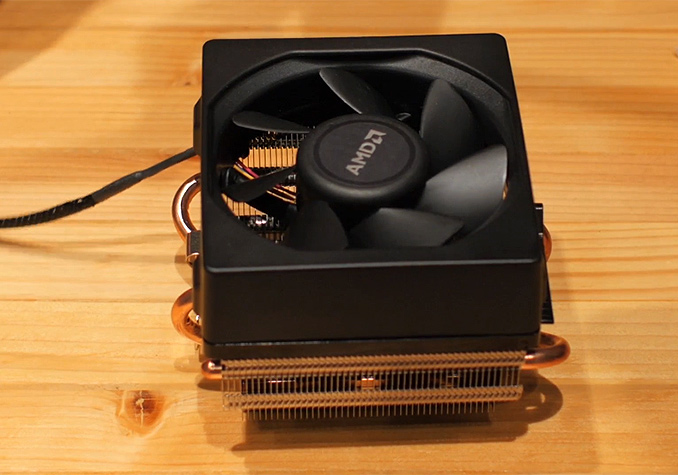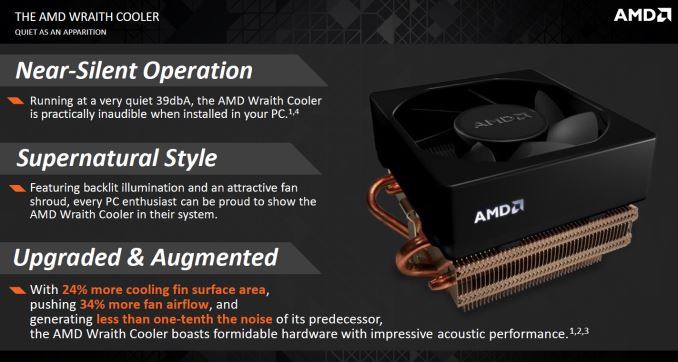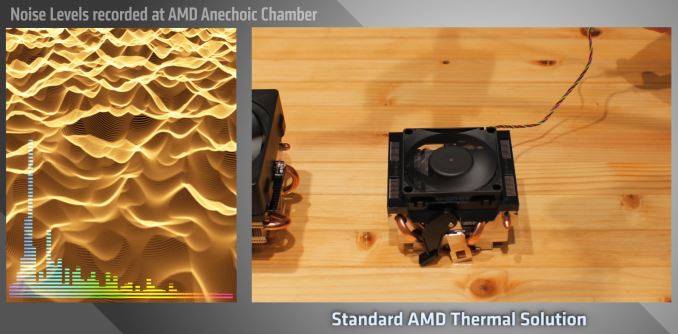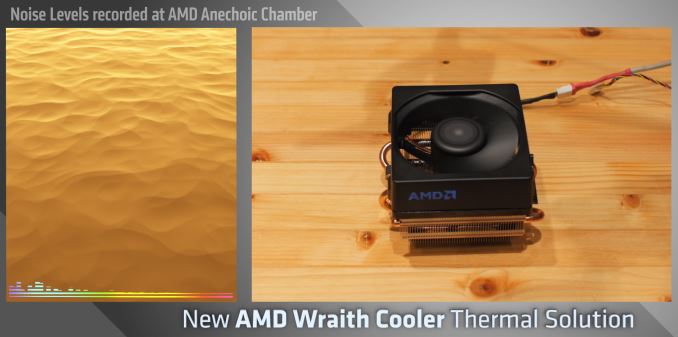AMD Reveals Wraith: Next-Generation Cooler for Microprocessors
by Anton Shilov on January 8, 2016 11:30 AM EST
Both AMD and Intel bundle cooling solutions with their microprocessors. Such coolers are inexpensive, they are rather reliable and they do their job. They are not supposed to enable great overclocking results, or be utterly quiet, unlike premium thermal solutions from the third parties. The two CPU developers are gradually working to improve their own coolers and this week AMD unveiled its new “Wraith” cooling system for its current and future chips.
At present, AMD equips its boxed FX-series central processing units (CPUs) with a rather small air cooler called the AMD D3. The latter is made of aluminum, is equipped with four heat-pipes as well as a 70-mm fan. The thermal solution can remove up to 125W of heat, but at the cost of a lot of noise (up to 51 dbA, according to AMD). The vast majority of enthusiasts, who buy AMD FX CPUs, usually obtain their thermal solutions from companies like Corsair, Noctua or Scythe. However, certain PC makers utilize bundled coolers, which may not be a very optimal decision since they get rather loud when CPUs get hot. AMD’s high-end accelerated processing units (APUs) can dissipate up to 95W, but their boxed versions are also equipped with rather tiny and noisy coolers, which is not a problem for power users (who use third-party solutions anyway), but is not exactly good for PC makers.
Apparently, AMD plans to offer better coolers with its microprocessors going forward. This week the company revealed its Wraith thermal solution, which will be used to cool down both current and upcoming chips from the developer. The AMD Wraith, which was designed to take away around 125W of heat, features a rather large aluminum heatsink with ultra-thin fins, four heat-pipes as well as an 80-mm fan. AMD claims that the Wraith features 24% more cooling fin surface area (179,730.1mm2) compared to its predecessor (144,397.8mm2), which seems like a significant improvement. Contemporary 80-mm fans can generate significant airflow while staying rather quiet. According to AMD, the new fan pushes 55.78 cubic feet of air per minute (CFM), or 34% more than the predecessor (41.6 CFM). The maximum noise level generated by the Wraith cooler is around 39 dBA (based on what AMD says), which is quieter compared to the current-generation D3 cooler from the company, but is significantly louder than noise levels generated by advanced coolers from companies like Noctua or Scythe (20 – 32 dBA, based on figures published by these manufacturers). Overall, the new cooler from AMD seems to be rather efficient for an in-box solution, but only real-world tests will show how good the Wraith cooling system actually is.
While AMD did not disclose all details about its new thermal solution, it did show it in action on its YouTube channel. The new cooler is noticeably larger than the AMD D3. It is also noticeably quieter, but it is clearly not as noiseless as 120mm low-RPM fans used on giant coolers.
The AMD Wraith cooling system will be bundled with select microprocessors going forward and will also be sold separately. The Wraith should be compatible with all recent AMD sockets (e.g., FM2+, AM3+, etc.), but we are not sure about the upcoming AM4 at this point. Since changing mounting mechanism of a cooler is not that hard, it looks like AMD’s Wraith will cool down the company’s chips for quite some time.
While enthusiasts will continue to use third-party coolers with AMD’s current and future central processing units, for many PC makers new thermal solutions will mean that AMD-based systems will get considerably quieter (which means generally more competitive). Since the Wraith is not large, it will fit into small form-factor systems. As a result, it will soon be possible to build an inexpensive SFF PC based on a high-performance AMD APU that will be relatively quiet.
AMD did not reveal when exactly it plans to start bundling the Wraith cooler with its chips, but expect the new thermal solution to show up in the coming months.













54 Comments
View All Comments
xrror - Sunday, January 10, 2016 - link
Well I said clips, not chips. All I meant is you might be able to re-use the Opteron 165 heatsink on an AM3+ board. Not the processor itself obviously.It would be pretty hilarious if AM4 kept the same/compatible mounting as AM3+ in this case, because an Opteron 165 heatsink on a Zen chip somehow would be re-use awesome =D
On a total tangent, from your mention of the 9NPA...
I actually had an Epox 8NPA, which was a really a bizarre but fun idea - It was a socket 754 board that used the nForce4 ultra. So yes single core but SLI. It made sense for that brief period where 754 chips were super cheap, dual-core wasn't quite there for games - but that window was but a few months before 939 chips became cheap (at least single core 939) which obviously made the board pointless. But still credit for a brave idea.
Sadly Epox retreated shortly after that from the retail market (or at least worldwide) ... I think they're still around as SUPoX or something, but I only find hits in asian markets and maybe just OEM?
I just wished for a last bios update that have let me run the Newark 4000+ mobile chip I had... argh that chip, never had a board that would run it right. *sigh* 1Mb cache, stock voltage of 1.35v @ 2.6Ghz. And none of the 4 754 boards I had ever had a bios that would run it right. aarrghh
Alexvrb - Sunday, January 10, 2016 - link
Sorry, I misread that. The single core wasn't a big deal in 754's heyday, mostly due to cost being substantially less than 939 setups. I had a friend that went 754 and I helped them with the build - another limitation was that it only had a single memory channel. Though again at that price it wasn't a dealbreaker. I went 939 for the upgrade path, started with a less expensive single core and eventually picked up an FX-60 on the cheap along with more (and faster) RAM.bigboxes: There were models of 4400+ that were socket 939, and there were models that were AM2. There were obviously differences but based on performance they were both marketed as 4400+. That happened all the time back then.
bigboxes - Saturday, January 9, 2016 - link
No, xrror was saying that the 4400+ was Socket 939 (which it was) and was saying that the cooler that came with it may have compatibility with an AM3+ mobo.My 4400+ was definitely a 939 cpu. I was using Abit at that time. I think it was a Toledo core.
hastypixels - Tuesday, January 26, 2016 - link
I still own that cooler! What a great piece of steampunk, that was. It shipped with my Athlon XP and never failed. The CPU itself was such a solid performer that it was a long time before I upgraded.In addition to architecture improvements, this is the sort of thing we need to see from AMD: Consideration for their hardware at every stage. I'm pleased to hear about the Wraith. It is effectively targeted at users who don't know or care that they can make their PCs quieter.
eanazag - Monday, January 11, 2016 - link
I was also thinking I have seen this cooler before Intel totally trounced them. I'm guessing the fan is quieter though. But the heatsink looks like it has been done before.jjj - Friday, January 8, 2016 - link
They should use a range of fans (speed wise) with it since it seems the fan is fixed speed. What's the point in bundling this with a 65W APU when a slower fan would do the job at lower noise. Assuming it's not gonna be for 90W and up only SKUs.tipoo - Friday, January 8, 2016 - link
Because the fan noise is already at the point where ambient noise and the rest of the system would drown it out, so why go slower. Having more air passing through also will allow it to hit turbo more.Valantar - Friday, January 8, 2016 - link
Uh, you do both realize that the demonstration in the video was likely run off of a straight 12V DC power supply, right? It demonstrates maximum noise from the cooler, which is kind of the point of a video like that. There is no such thing as a fixed RPM computer fan, and even if it lacked PWM control (which I seriously doubt - haven't seen a CPU cooler without that for at least a decade) it would be controllable through voltage.jjj - Friday, January 8, 2016 - link
Maybe before thinking you know better, you could get informed. The fan is constant speed and if you do that , you might as well use the right fan for the TDP/speed for better results.Trixanity - Friday, January 8, 2016 - link
Let me get this straight. You're saying this fan (which runs at maximum speed in the demonstration) can only run at this speed and that PWM wouldn't change the speed of the fan like it does for all other fans? Or are you trying to say that they should make fans with varying maximum speed? Both seems fairly wrong. The fan will be temperature regulated through PWM. So it will most likely run lower than the demonstrated speed the majority of the time. A lot of people buy Noctua fans running at 1200 RPM and reduce the speed themselves to like 500 RPM.